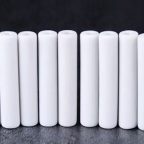Zirconia ceramic binders Wax-based or oil-based binders, water-based binders and solid polymer solutions. Zirconia ceramic wax-based binders usually contain 3-4 components, and the polymer controls the flow viscosity, green product (green body before sintering) strength and degreasing characteristics. The short molecular chains have good forming properties and can minimize orientation effects in the forming element.
Zirconia wax or oil is the main filler and is removed during the initial stage of degreasing. Zirconia ceramic surfactants are used to improve the compatibility of powders with binders. Zirconia ceramic plasticizers are used to adjust the flow properties of polymers. Zirconia ceramic water-based binders contain water-soluble polymers, gels or water glass. This type of zirconia ceramic binder is usually formed by low pressure to avoid powder and binder separation and reduce mold wear and residual stress.
Zirconia ceramics are easy to remove due to water, which makes it possible to make thicker elements. The coagulation or gelling of the binder solution imparts strength to the green product. Before the zirconia ceramic is sintered, the water evaporates or sublimates from the raw product to minimize deformation. New binder formulations using solid polymer solutions of polystyrene have been used to avoid deformation. The main filler is removed by solution dipping. Since the skeleton structure of polystyrene cannot be weakened, deformation of the raw product is avoided. Primary fillers are small organic molecules that have both benzene rings and polar groups. The benzene ring makes it soluble in polystyrene when mixed, and the polar group makes it soluble in solvents such as water or alcohol when degreased.
Common zirconia ceramic binders include polypropylene (PP), random polypropylene (APP), polyethylene (PE), ethylene-vinyl acetate copolymer (EVA), polystyrene (PS), acrylic resin, etc. . Among them, PE has excellent formability; EVA has good compatibility with other resins, as well as good fluidity and formability; APP has the characteristics of good compatibility with other resins, rich in fluidity and degreasing; PS has good fluidity. Additives include wax paraffin, microcrystalline paraffin, modified paraffin, natural paraffin, stearic acid, compounding agents, etc. The fluidity of the zirconia ceramic molding material can be evaluated using a high-flow pour point tester and a melting indexer. When the content of the binder in the degreasing agent is high, the degreasing property tends to decrease, and the degreasing property is good when the paraffin wax of the auxiliary agent is large. If the organic material cannot be completely scattered in a specific temperature range, it will affect the sintering of the ceramic, so it is necessary to consider the thermal decomposition characteristics and select it.
Related Reading:
- What problems should be paid attention to when using new zirconia ceramic tools?
- How to use zirconia ceramic knife correctly?
- Common problems of zirconia ceramic grinding technology difficulties
- Research and development direction of new zirconia ceramics
Pintejin machining ceramic service include : Alumina Ceramic Parts, Zirconia Ceramic, Silicon Carbide Ceramic, CNC Machined Aluminum Nitride Ceramic, Machinable Ceramic Parts, Glass Ceramic,Macor Ceramic,Powder Metallurgy Dies,Ceramic Injection Molding,Ceramic Dry Pressing,Ceramic Extrusion Dies




